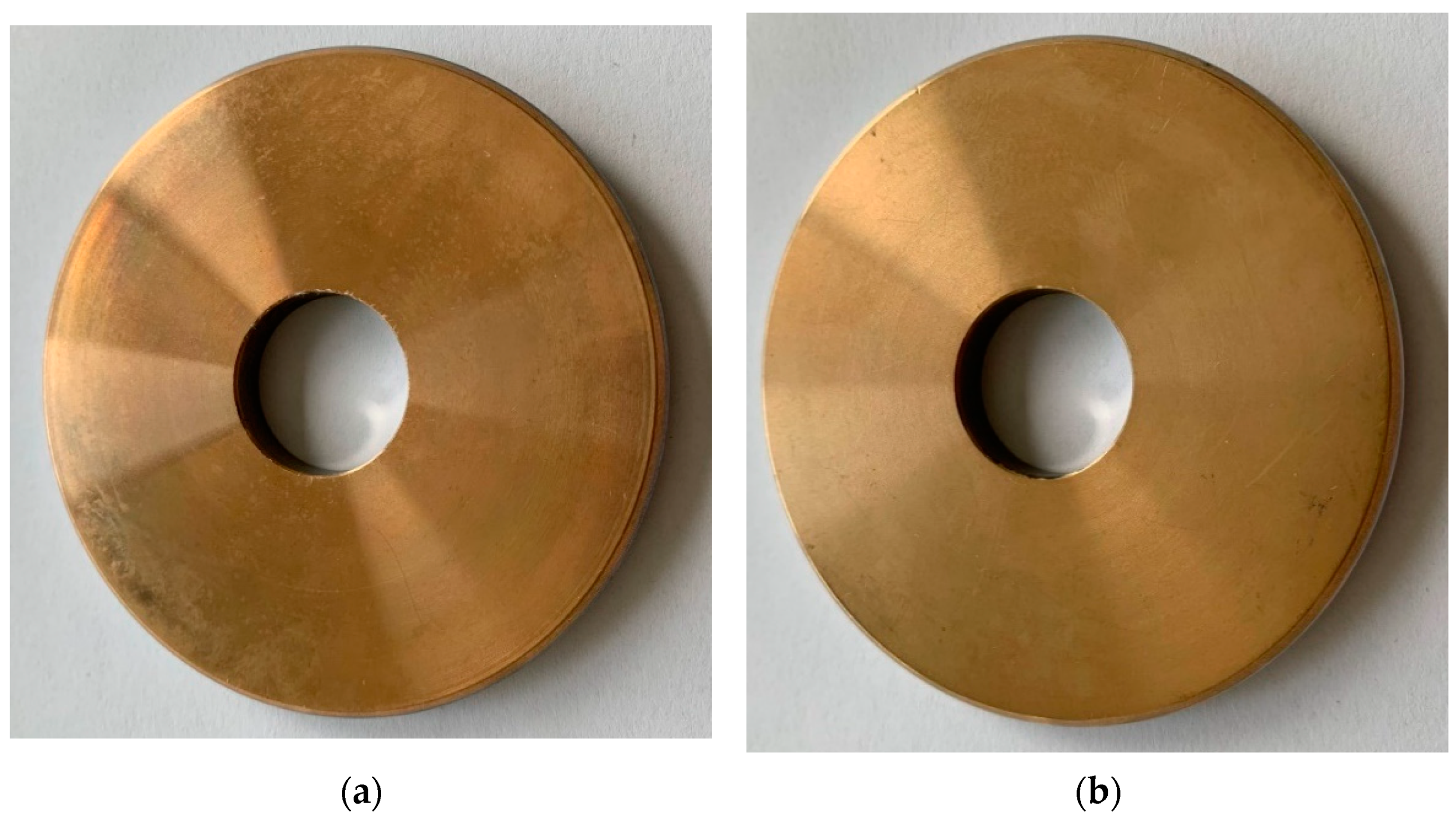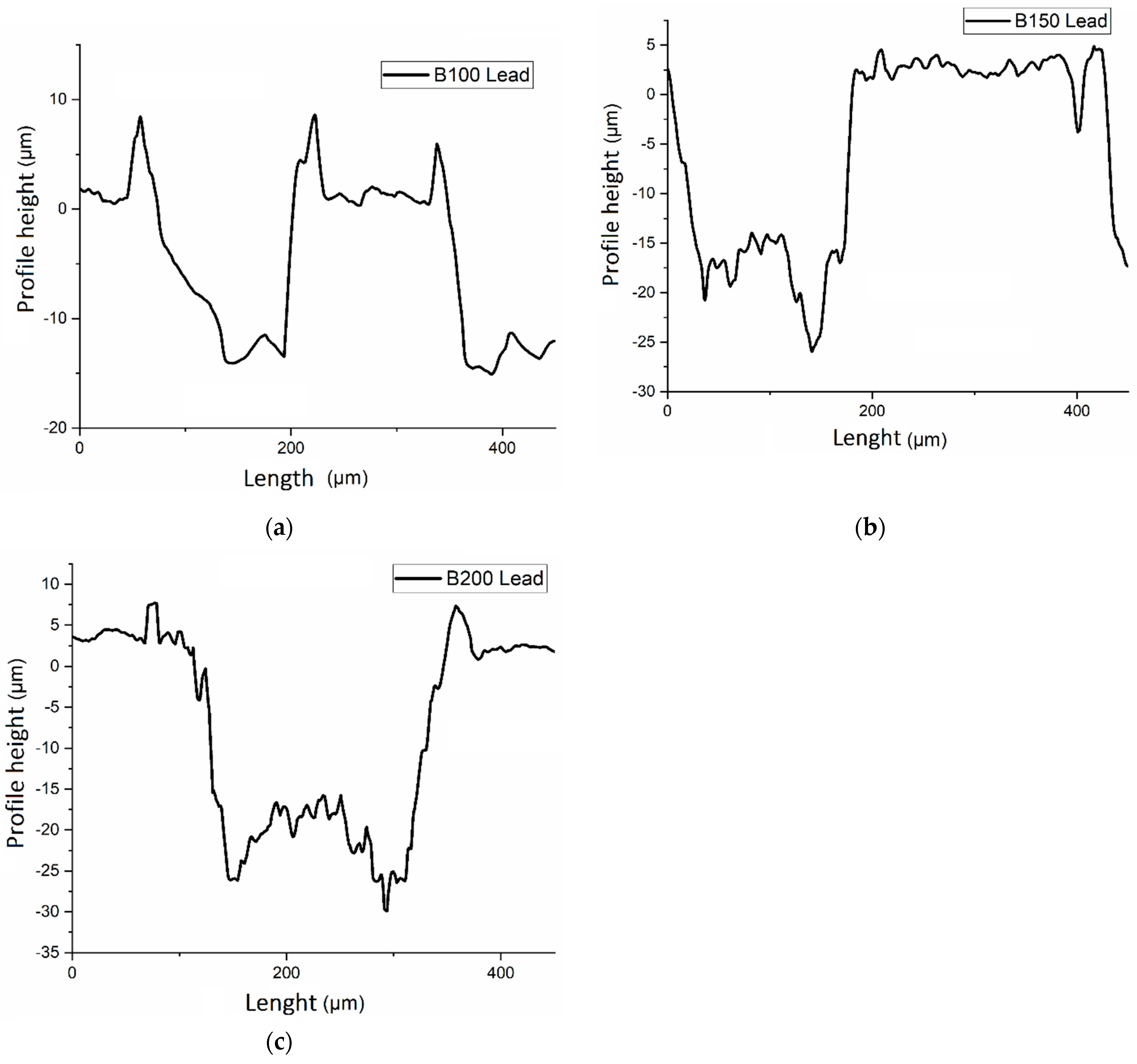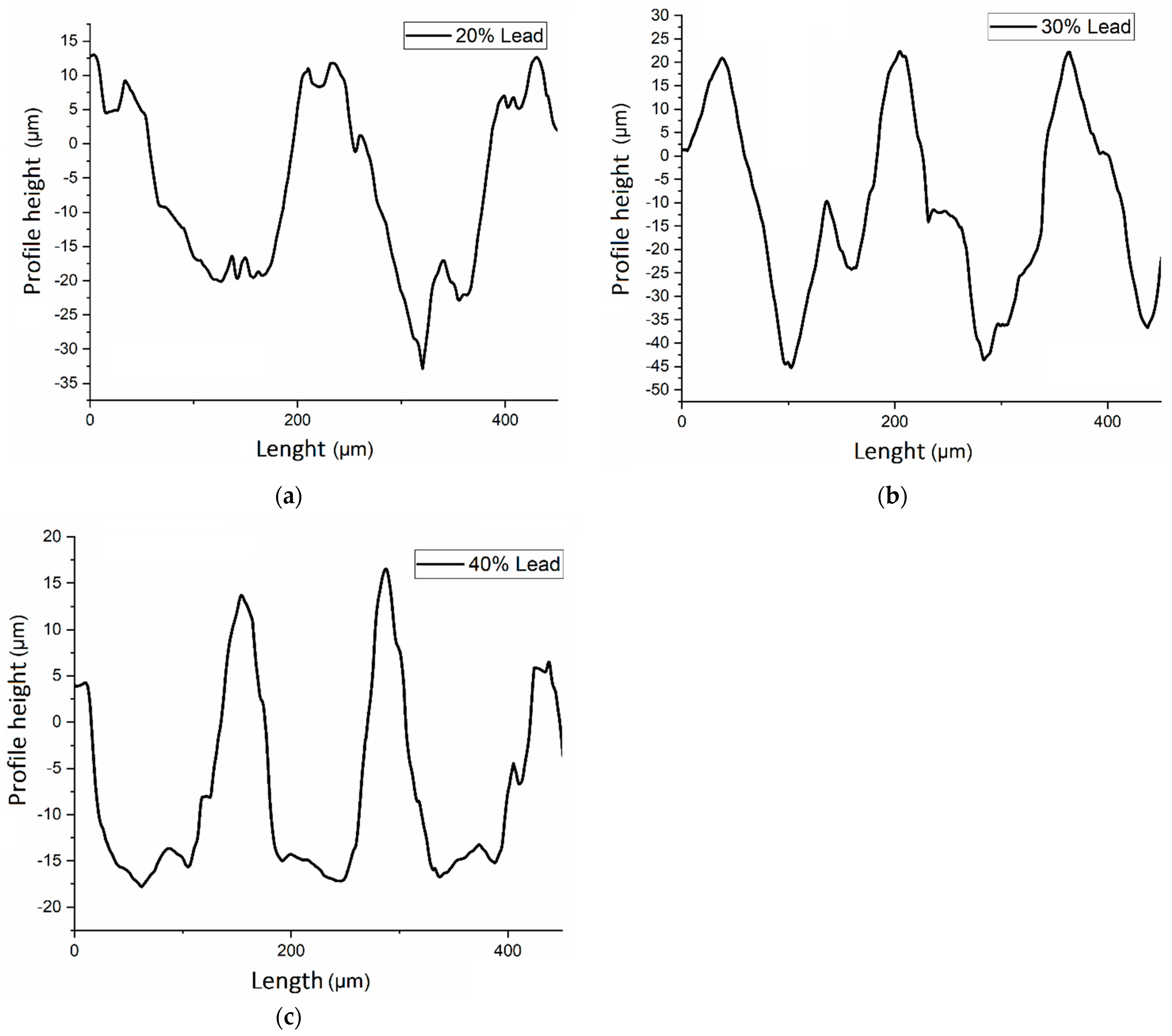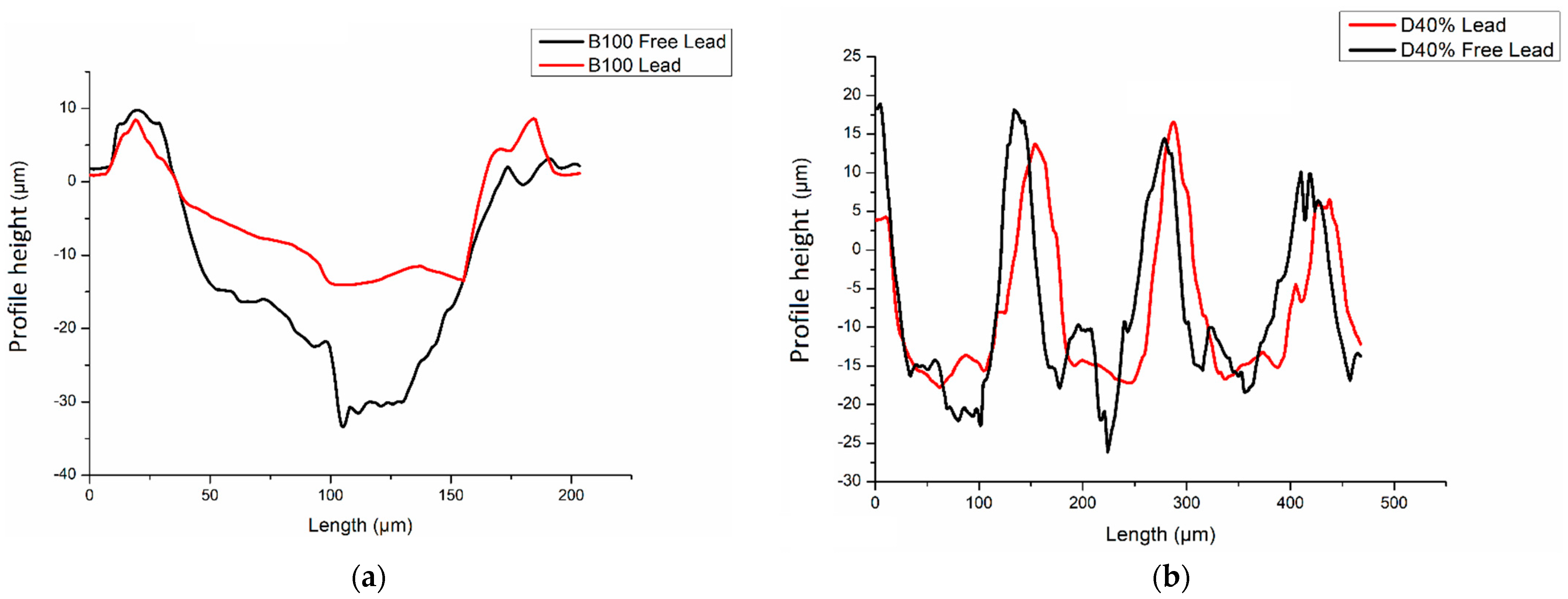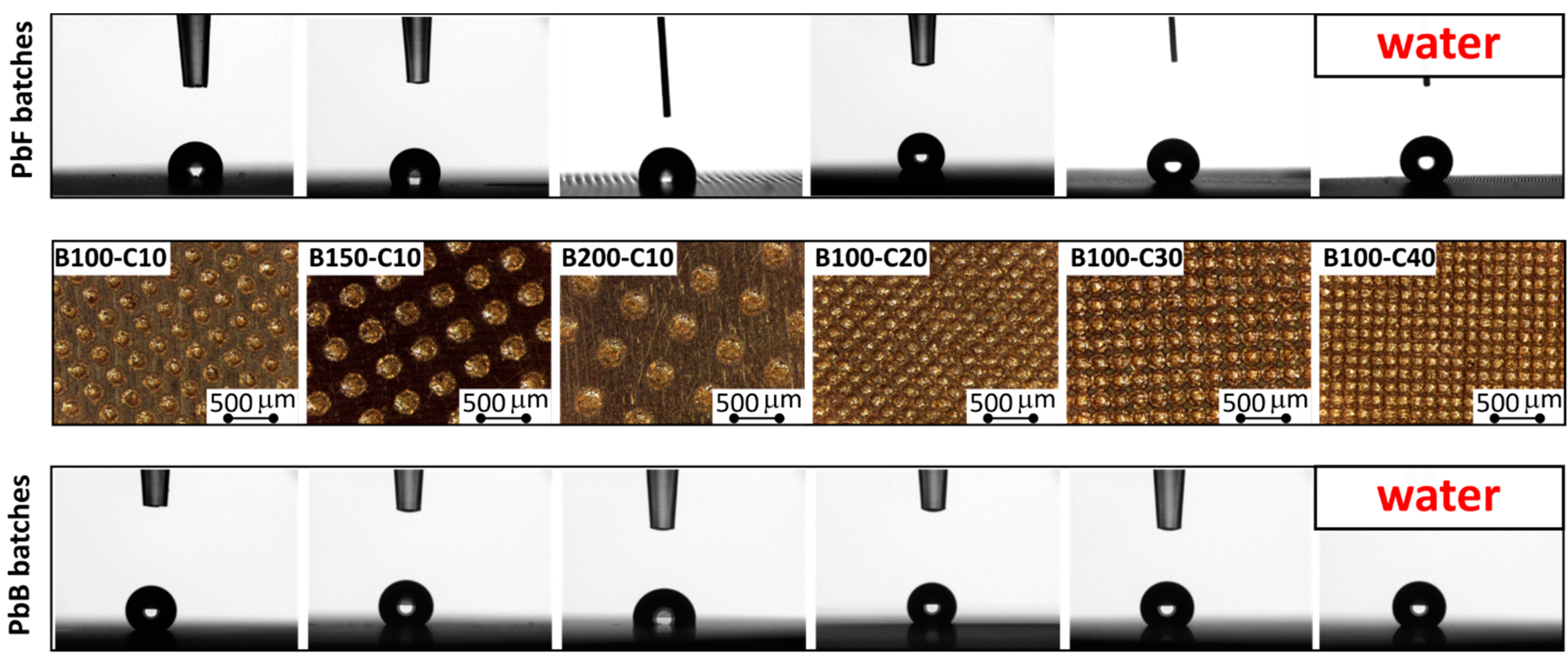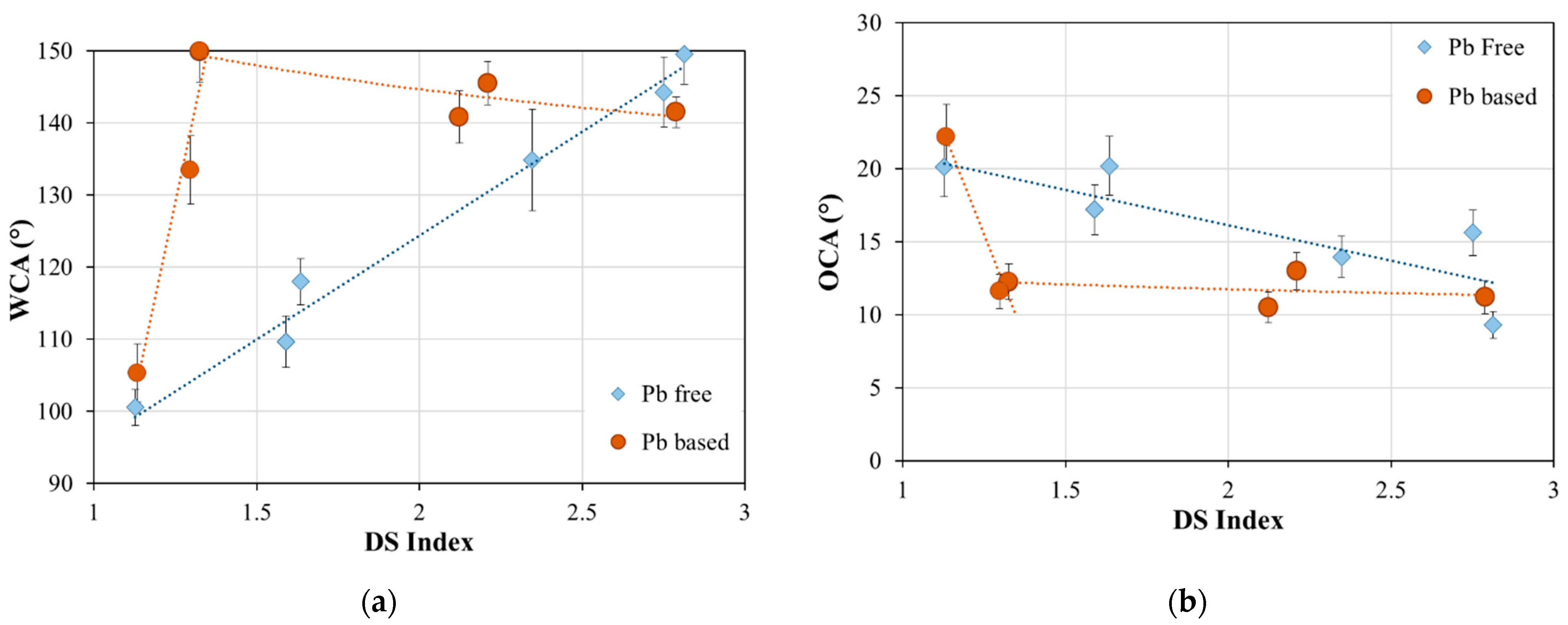3.1. Surface Morphology
To better evaluate the surface characteristics of the coatings and the geometry of the dimples, confocal microscopies were carried out on both the EN CC480K alloy coating and the EN CC496K alloy coating.
Figure 2 shows the 3D scans of the AR samples (
Figure 2a,b) and those of two B150-D10 textured samples (
Figure 2c,d). As reported in
Table 4, the surface of the PbB-AR sample had a higher average roughness than the PbF-AR sample, measuring approximately 100 nm. This may have been because lead bronze alloys exploit the insolubility of lead in copper to create lead-free globules in a copper–tin matrix. The soft lead phase deformed easily and was smeared on the surface to form a solid lubricant, leaving empty pockets that could have been the cause of the increased roughness.
As shown in
Figure 2c,d, the dimensions of the dimples were comparable with the project dimension, although the surface laser texturing technique did not allow them to have a perfect hemisphere. However, it should be noted that the surface laser texturing process caused asperities called pile-ups, which increased the surface roughness by involving an increase in friction and possible debris formation [
27,
39].
To evaluate the effects of the surface laser texturing on the surface of the bronze coatings, the roughness profiles of the textured samples obtained by varying the diameter of the dimples (
Figure 3) and the profiles of the textured samples obtained by varying the density of the dimples were compared (
Figure 4). The roughness profiles were obtained while taking into consideration the portion of the specimen with the maximum density of dimples. When examining the graphs in
Figure 3, it is possible to notice some of the negative aspects related to the laser beam texturing technique. In fact, by increasing the diameter of the dimples, the depth of the dimples also increased, reaching peaks of 30 µm (
Figure 3c). This was due to the inability of the diameter of the laser beam to draw a perfect hemisphere. Furthermore, as shown in
Table 5, as the diameter of the dimples increased, the average surface roughness also increased. This aspect was probably due to the formation of pile-ups (more visible in
Figure 3a), which were much greater than the quantity of material removed.
Figure 4 shows a comparison of the roughness profiles as the density varied. What should be noted when analyzing the curves is that the greater the density of the dimples on the surface, the smaller the portion of material that separated one dimple from another, until it became real roughness in the case of the PbB-B100-D40 sample. While the increase in the density of the dimples ensured a more effective lubrication due to the greater presence of “oil reservoirs” on the surface, on the other hand, it also involved a substantial increase in the surface roughness, approximately 3–4 times greater than that obtained by varying the diameter of the dimples. Furthermore, as shown in
Table 6, in this case the depth values for the dimples that were obtained were even higher than in the previous case, up to 40–45 µm in depth. However, as will be analyzed in the next chapter, a greater increase in roughness led to an increase in the hydrophobic characteristics of the coatings.
Figure 5 shows a comparison of the roughness profiles of the lead-free bronze and lead bronze samples. As shown in
Figure 5a,b, in the cases of both the PbB-B100-D10 and PbB-B100-D40 samples, the profile drawn by the dimples had a more regular trend, and the lower surface of the dimples had a less-indented appearance. This more regular trend was justified by the lower hardness of the lead bronze coating compared to the free-lead bronze. In fact, for both the PbF-B100-D10 and PbB-B100-D40 samples, the depths of the dimples were much greater than that defined in
Table 2, and this was justified by the longer time taken by the laser to melt the coating.
Figure 6 shows the statistical parameters of the surface profile used to analyze the correspondence between the geometric design parameters of the texture and the real geometric parameters averaged as a function of 10 measurements for each type of texture. Therefore, by analyzing the statistical parameters of the texture, the numerical values of which are shown in
Table 7, it was possible to confirm that the surface laser texturing process generated a variability of a few tens of microns with respect to the design values, and this was due to the diameter of the laser beam of the machine used, as well as the type of material. It is important to specify that the data were obtained while considering both the PbF and PbB specimens to have broader statistical data. However, as already mentioned, and as shown in
Figure 5, there was a difference in workability between the two types of coatings that certainly depended on the presence of lead.
3.2. Surface Wettability
In order to better correlate the morphologies of the textured surfaces with the surface properties of the bronze coatings, wettability measurements were carried out. Some representative images of 3 mL droplets deposited on the textured surfaces, with varying surface texturing, are shown in
Figure 7 and
Figure 8 for both the Pb-based and Pb-free coated surfaces. In particular, the wettability measurements were carried out with water (polar liquid—
Figure 7) and pumping oil (nonpolar liquid 002D—
Figure 8).
When evaluating the wettability results, an evident correlation of the surface properties with the polar and nonpolar characteristics of the liquid was identified. All the specimens in both the PbB and PbF batches showed a predominantly hydrophobic behavior with water and an oleophilic one with pump oil. In particular, the surfaces showed a strong interaction with the oil, which spread easily in the interstices of the textured surface, which led to very low contact angles.
Moreover, it is worth noting that the texturing procedure contributed significantly to modifying the surface properties of the bronze coatings. The PbB-AR and PbF-AR specimens showed a more evident surface hydrophilicity and a less marked oleophilic one compared to the surface-treated ones. This qualitatively suggested that the surface without laser treatment did not allow selective operation toward liquids, potentially offering a less-effective lubricating capacity.
In order to be able to better quantitatively correlate the surface wettability performances with the surface morphologies,
Table 8 summarizes the water contact angle (WCA) and pump oil contact angle (OCA) for all the investigated batches.
Concerning the PbF batch, the laser surface texturing induced an increase in the contact angle in a range of about 15°–50°. The higher result was observed for PbF-B100-D30, which showed a WCA of 149.5°, close to the superhydrophobic threshold [
31].
When evaluating the evolution of the WCA values with varied surface texturing, it was seen that the dimple size played a less-relevant role than the dimple density. Indeed, the specimens characterized by the same density and a growing dimple size showed slight similar water contact angle values. Conversely, with increasing dimple density, a significant increase in the hydrophobic surface properties occurred.
In addition, when assessing the evolution of the OCA trend when varying the surface texturing, the oleophilic properties were quite similar, if not worse. Only the PbF-B100-D30 batch showed an evident increase in the interfacial affinity with nonpolar liquids, as shown by an average OCA value of 9.3°.
Different considerations could be addressed by evaluating the contact angle values for the PbB batches. For samples with the lead-based bronze coating, the laser surface texturing had an evident effect on the surface wettability performances. A coupled increase in the hydrophobic and oleophilic behaviors took place. All samples characterized by a laser beam diameter of 100 µm exhibited a WCA close to 150°. Furthermore, the OCA experienced a reduction of up to 20°.
Not only the liquid/solid contact angles were evaluated, but also the sliding angles, in order to understand the surface wettability behavior [
40]. All the samples before and after texturing showed a high liquid sliding angle (90°), indicating a high liquid adhesion (data not reported in the table). Thus, creating a textured structure did not change the water adhesion on the sample surface, regardless of the coating nature.
The marked hydrophobic and oleophilic behaviors found in the laser-textured samples could be related to the intrinsic surface morphology acquired by the coatings at the end of the surface treatment. The resulting surface profile was constituted by a larger number of peaks and valleys, making the surface regularly jagged and rough.
This was in accordance with Wenzel’s theory, which relates the surface roughness to the liquid/solid contact angle [
41,
42]. Indeed, Wenzel proposed a relationship between the surface-roughness ratio (
R: ratio of the rough surface area to the smooth surface one) and the contact angles on smooth and rough surfaces:
where
θw is the Wenzel contact angle (contact angle on rough surface) and
θ is the ideal contact angle (contact angle on smooth surface). According to this equation, by increasing the surface roughness, the hydrophobic surface becomes more hydrophobic, and the hydrophilic surface becomes more hydrophilic [
43]. In fact, as shown in
Table 4, both PbR_AR and PbB-AR were hydrophobic and oleophilic before texturing, and they become more hydrophobic and oleophilic after texturing. In this Wenzel state, the liquid penetrated the rough surface cavities; such behavior is known as the homogenous wetting mode, in which the interaction and the adhesion between the liquid and the solid surface are high [
44].
In order to better investigate the correlation between the wettability and the characteristics of the surface profile of the specimens, an index related to the dimples’ surface morphologies, named the DS index, was calculated according to the following expression:
where
d and
h are the diameter and height of the dimple, respectively. Consequently,
is the dimple area, and
S is the length of the peak between two dimples. All the measurements were defined in µm, thus the DS index was expressed in µm. The greater this index, the greater the contribution of the cavities to the surface peaks.
Figure 9 shows the evolution of the water contact angle (WCA) and oil contact angle (OCA) with the DS index for Pb-based and Pb-free textured samples.
For PbF batches (blue diamond marker in
Figure 9), the WCA and OCA had a quite good linear relationship with the DS index. The slope increased for the WCA values, and vice versa (the slope decreased for the OCA). This result suggested that an increase in the size of the dimples and their depth played a key role in enhancing the hydrophobic and oleophilic behavior of the surface.
For the PbB batches (orange circle marker in
Figure 9), a clear bilinear trend in the WCA and OCA vs. DS index could instead be identified. The trend initially showed a strong change in the contact angles due to a slight change in the DS index. The slope of the fitting line (positive for WCA and negative for OCA) was very high. Subsequently, for values of DS > 1.4, the trend showed a plateau zone. An increase in the dimple shape (diameter and depth) did not provide a statistically significant change in the contact angle. The fitting line had a very low slope, indicating a trend almost parallel to the
x axis.
This behavior showed that for the PbB batch, a very extensive and invasive laser texturing was not necessary to induce a surface-modification effect in the coating. A DS index close to 4 was sufficient to guarantee an effective surface hydrophilicity and hydrophobicity.
Based on wettability measurements with oil and water, it was possible to assess that the porous textured surface was tailored to act an oil reservoir thanks to its good oleophilic behavior. This can prolong the life of lubricating oil layer and may result in a superior wear resistance. Furthermore, a relevant hydrophobicity was highlighted, suggesting that the surface texturing promoted the water-repellent barrier action on the surface.
